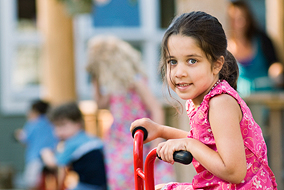 UBC Child Care Services serve about 500 children, making it Vancouver’s largest daycare provider - photo by Martin Dee UBC Reports | Vol. 55 | No. 8 | Aug. 6, 2009
UBC Child Care adds five new daycare centres
By Lissa Cowan
Daycares facilitate meeting of minds
UBC’s Child Care service marks its 40th anniversary this month and there’s plenty to celebrate: five new daycare facilities have opened in 2009, with others on the drawing board for the near future.
“The need to expand has been clear for a number of years, but the demand was so great we’ve had to open a number at once,” says Darcelle Cottons, director of UBC Child Care Services. “Even doing that hasn’t shortened our waiting list as much as it should.”
Staff turnover and a demographic change on campus are driving the demand. As well, new housing on campus may mean a rise in the number of young families in the near future, Cottons says.
The waiting list for one of the child care spaces is now 15-18 months, down from a recent high of three years. About 500 children, from the age of four months to 12 years, are enrolled in the centres.
UBC Child Care Services is already the largest campus-based child care system in North America, and the largest provider of infant and toddler childcare in Vancouver.
However, a steering committee of students, faculty, staff, community members and members of the administration is looking at how UBC can double the number of childcare spaces on campus, says Nancy Knight, associate vice-president campus and community planning.
The administration will be providing the board of governors with a report this fall, in part based on the feedback received during a recent open house.
Operating in tandem with a large university often leads to interesting research projects pioneered by staff and students. Four of the 12 centres is experimenting with grouping toddlers with preschool-aged children, a first in Canada and a move that could lead a nationwide change.
Rather than splitting the youngest kids into two groups – toddlers and three-to-five year olds – researchers are experimenting with grouping the children into a bigger space with a smaller child-to-staff ratio.
“For young children, relationships are critical, and this allows the child to be with the same caregivers for up to four years,” Cottons says.
“Innovation is what we’re all about: finding better ways to do what we do,” she says. “The community interest in this project is huge.”
UBC Child Care services operate on one campus block, giving parents and staff greater access to each other.
“The community is made up mostly of students, faculty and staff, but they’re all just someone’s parent,” says Cottons. The daycares often host potluck dinners, where parents can get to know each other socially.
It was at one such potluck that Todd Handy, the director of the neuroimaging lab in the UBC Department of Psychology, met Lara Boyd, a UBC physical therapist and neuroscientist.
They got to talking, and found they had common interests.
Her work involves studying how people recover motor function after having strokes. She had a new study to contact, but didn’t have necessary equipment. Handy did.
“It just so happened I had a spare EEG recording system she could borrow,” he says.
That chance meeting last fall has led to an ongoing research collaboration that marries cognitive neuroscience and physical therapy.
“It’s sometimes challenging to make connections on this campus for interdisciplinary research,” says ErinRose Handy, communications manager for the Faculty of Applied Science and parent of two children in the system. “The daycares provide opportunity on this campus to connect with people from different faculties.”
|
